Banco Ambrosiano Scandal
Suicide Corrected as Murder
Prince Bernhard vetoed Pope John Paul I
House of Cards
Scandalised Money Laundering
Banco Ambrosiano Scandal
The apparent suicide in June, 1982 of an Italian financier known as ”God’s banker,” who was found hanged beneath London’s Blackfriars Bridge, has added to the mystery of a major Italian financial scandal in which the Vatican appears heavily involved.
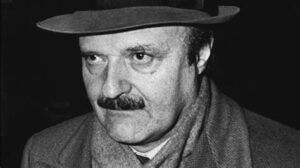 Five days after he vanished, his secretary jumped to her death from a window of the Milan bank. Mr. Calvi 61 years old was found in London hanging from a rope under Blackfriars Bridge on June 18, 1982.
Five days after he vanished, his secretary jumped to her death from a window of the Milan bank. Mr. Calvi 61 years old was found in London hanging from a rope under Blackfriars Bridge on June 18, 1982.
He had joined Milan’s Banco Ambrosiano as a clerk, worked his way up to become its president and, along the way, through a series of spectacular deals, transformed what had been a modest regional bank into a major financial power, with assets of $18.7 billion in 1981.
”The Ambrosiano affair makes everyone wonder about the Vatican’s finances, but it really illustrates the fragility of the international banking system that we are all trying to preserve,” said Guido Carli, a former governor of the Bank of Italy and now a prominent industrialist.
As usual with such scandals in Italy, there are also unverifiable reports of the involvement of organised crime figures and even a recently discovered secret Masonic lodge opposed to the government that are somehow involved.
There are also reports that Banco Ambrosiano may have been a target of the British secret service, which is said to suspect it of financing Argentine arms purchases during the war over the Falkland Islands.
The Bank of Italy first became suspicious about Banco Ambrosiano in 1978 during a general crackdown on bank fraud, but immediately ran into a heavy political opposition.
This Vatican bank is officially known as the Institute of Religious Relations, from 1971 to 1989 its President was Archbishop Paul Marcinkus from Cicero, Illinois. Before that, he worked as a bodyguard for Pope Paul VI. However, he will be remembered for a scandal that broke out in 1982.
Suicide Corrected as Murder
The scandal began with the collapse of Banco Ambrosiano, one of Italy’s largest private banks, with a debt of $1.4 billion. Soon after, Roberto Calvi, the bank’s managing director and friend of Marcinkus, was found dead hanging under a bridge over the river Thames in London, in England.
The location of Blackfriars bridge was seen as indicating a link to P2 because members of the illegal group referred to themselves as ‘frati neri’, Italian for ‘black friars’.
T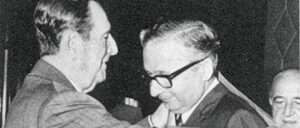 he death of Calvi, the bank’s chairman and a P2 member, was initially deemed to have been a suicide. But subsequent investigations pointed to it having been a murder which Italian prosecutors believe was the work of the Sicilian Mafia.
he death of Calvi, the bank’s chairman and a P2 member, was initially deemed to have been a suicide. But subsequent investigations pointed to it having been a murder which Italian prosecutors believe was the work of the Sicilian Mafia.
The organised crime syndicate had used Ambrosiano to recycle funds, some of which were moved out of Italy via the Vatican bank. No-one was ever convicted for carrying out or commissioning Calvi ‘s murder.
Five people, including mafia boss Masonic grand master Licio Gelli were tried in connection with his murder, but were all acquitted. It is best known internationally for having been at the heart of a murder mystery involving both the Mafia and the Vatican that centred on the death of “God’s banker”!
It appears that the Vatican, through the Vatican Bank, is the main shareholder of Banco Ambrosiano and that they have channelled a billion dollars from the bank to 10 subsidiaries. Several rumours surrounding the scandal were, that other shareholders at the bank were involved in this organised crime and some were even members of the secret Masonic lodge-P2.
When Italian investigators tried to interview Marcinkus about the scandal, he was uncooperative. He refused to leave the Vatican and even refused to answer questions, referring to his diplomatic immunity.
Marcinkus was eventually indicted, but he never went to trial because the charges against him were dismissed. He remained in charge of the Vatican bank for seven years.
Prince Bernhard vetoed Pope John Paul I
 The scandal even gave rise to some conspiracy theories. The most famous was used in the plot of Godfather Part III, as Pope John Paul I was assassinated by the mafia on orders in August 1978. John Paul I had been chosen as Pope in 1978, but Prince Bernhard the prince of the Netherlands vetoed it. He was found dead in bed after only 33 days in office. The official cause of death was a heart attack, but no autopsy was performed. According to the conspiracy theory, he was killed because he wanted to end the relationship between the church and the private bank.
The scandal even gave rise to some conspiracy theories. The most famous was used in the plot of Godfather Part III, as Pope John Paul I was assassinated by the mafia on orders in August 1978. John Paul I had been chosen as Pope in 1978, but Prince Bernhard the prince of the Netherlands vetoed it. He was found dead in bed after only 33 days in office. The official cause of death was a heart attack, but no autopsy was performed. According to the conspiracy theory, he was killed because he wanted to end the relationship between the church and the private bank.
According to senior officials investigating the scandal who do not wish to be identified, the Banco Ambrosiano affair centres on the close but ambiguous relationship between Mr. Calvi and Archbishop Paul C. Marcinkus, a 60-year-old native of Cicero, Ill., who for the last 10 years has run the Vatican’s free-wheeling but extremely secretive bank. The bank’s formal name is Instituto per le Opere de Religione, the Institute for Religious Works, and it is commonly referred to as I.O.R.
Archbishop Marcinkus, a former chief of papal security, has been a controversial figure in financial circles because, as head of the Vatican bank, he was responsible for the Vatican’s losing a reported $30 million in the collapse in 1974 of the business empire of Michele Sindona, the Sicilian financier.
During 1980 and 1981, investigating officials say, the late Mr. Calvi mounted an extensive lending program to the Peruvian, Nicaraguan and Nassau subsidiaries of the Banco Ambrosiano group, using funds borrowed in the Eurodollar market that eventually totalled some $1.2 billion to $1.4 billion.
Most of this money was then lent to a series of Panamanian companies with names such as Bellatrix Inc., Manic Inc. and Astrolfine Inc., most of which are thought to have no more than mail addresses. The loans were granted roughly evenly by Banco Ambrosiano in Milan and by its Luxembourg subsidiary, Banco Ambrosiano Holdings.
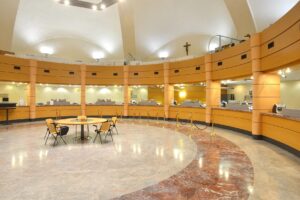 But Mr. Calvi lent these funds, investigators say, only after receiving what bankers call ”letters of comfort” from the Vatican bank. These letters, though vaguely worded, implied that the Vatican had an interest in the companies and was aware of their borrowing plans. Although such letters do not constitute a legal guarantee that the signatory will repay the loans, they are often issued to reassure lenders that a borrowing company has reputable backing.
But Mr. Calvi lent these funds, investigators say, only after receiving what bankers call ”letters of comfort” from the Vatican bank. These letters, though vaguely worded, implied that the Vatican had an interest in the companies and was aware of their borrowing plans. Although such letters do not constitute a legal guarantee that the signatory will repay the loans, they are often issued to reassure lenders that a borrowing company has reputable backing.
But the Vatican bank also demanded and received what investigators call a ”counter letter” signed by Mr. Calvi and absolving it from all legal and financial responsibility for the loans to the Panamanian companies.
Investigating officials believe the Vatican did have an interest in the Panamanian companies and probably controlled a number of them. But they are convinced that Mr. Calvi was also part owner and effective manager of most of the companies and used the money they borrowed to buy shares in Banco Ambrosiano and probably in other companies as well.
By now, one senior official involved in the investigation estimates, the Panamanian companies own around 20 percent of Banco Ambrosiano.
House of Cards
As interest rates rose and the dollar strengthened, investigators found it likely that it became increasingly difficult for Mr Calvi to pay his loans in dollars with the dividends from his shares, which were often paid out in weak Italian lira. To remain solvent, he was forced to borrow more.
”It was a house of cards that was bound to fall down,”
one official said.
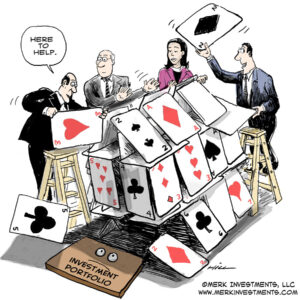 There is speculation that the Archbishop may have agreed to the deal to help out an old colleague and financial adviser since Banco Ambrosiano is regarded as one of Italy’s ”Catholic” banks with longstanding links to the Vatican. He may also have wished to protect the Vatican’s own stake in Banco Ambrosiano, which is assumed to be far more than the 1.8 percent shown by the latest official figures.
There is speculation that the Archbishop may have agreed to the deal to help out an old colleague and financial adviser since Banco Ambrosiano is regarded as one of Italy’s ”Catholic” banks with longstanding links to the Vatican. He may also have wished to protect the Vatican’s own stake in Banco Ambrosiano, which is assumed to be far more than the 1.8 percent shown by the latest official figures.
In the view of the Italian Treasury Minister, Nino Andreatta, and of Mr. Campi, the central bank’s governor, the Vatican acted improperly in issuing letters of comfort to Banco Ambrosiano at the same time as it asked the bank to absolve it from any responsibility for the Panamian companies. They believe it must therefore bear at least a moral responsibility for any losses incurred, according to senior officials.
Toward the end of his life, Mr. Calvi is said to have become increasingly involved with suspected underworld figures as his needs for ready cash increased. There are also rumours that he lent Peru $200 million to buy Exocet missiles for the Argentine forces during the Falkland war and thus became a target for the British secret service.
In light of the rumours, officials at the normally staid Bank of Italy and Finance Ministry expressed amazement at the finding by a London coroner that Mr. Calvi did indeed commit suicide by hanging himself under the bridge. The common reaction was:
”Why bother to go to London to do that?”
Scandalised Money Laundering
Paolo Cipriani, director of the bank, and his deputy Marco Tullio have resigned after the arrest by Italian tax police of a Vatican monsignor who used to work as a senior account manager in the Administration of the Patrimony of the Apostolic See (APSA), which manages Vatican real estate holdings. The monsignor, Nunzio Scarano, is being questioned in jail over allegations of money laundering, corruption and fraud.
Pope Francis is scandalised and angry at the goings on behind the scenes at the IOR. He has decided to begin his planned clean-up of the Roman Curia, the central government of the Church, with a complete shakeup at the IOR.
Vatican security officers have been instructed to freeze any attempt to meddle with IOR documents, while an internal commission of inquiry with wide powers prepares a secret report on the current financial shenanigans, for the eyes of Pope Francis only.
The Vatican Bank has a damaged image at a time when the Pope is urging his flock to turn their attention to the plight of the world’s poor. There is speculation that one of Pope Francis’ options could be to dissolve the IOR altogether and transfer all Vatican banking to a reliable commercial bank.
Stay informed and subscribe for free, with no hidden commercial interest, it is at our cost that you will be kept informed.
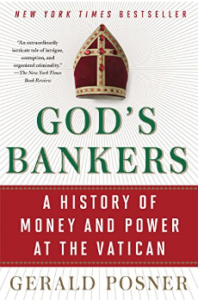 Watch the documentary God’s Banker about worldwide money laundering, The Vatican bank, Masonic secret service and the Italian mafia.
Watch the documentary God’s Banker about worldwide money laundering, The Vatican bank, Masonic secret service and the Italian mafia.
https://sflix.to/watch-tv/free-murder-of-gods-banker-hd-95965.9582313
Leave a Reply